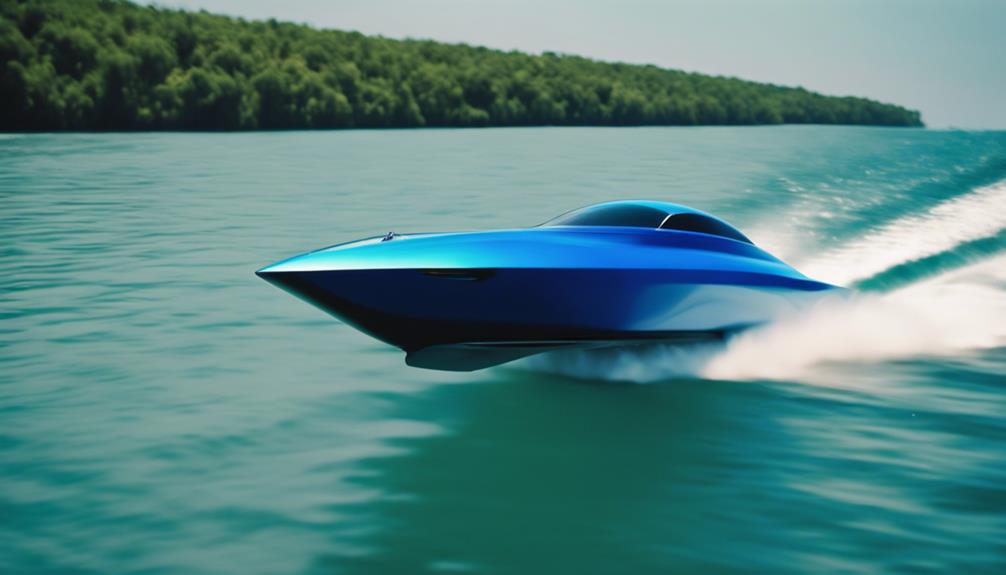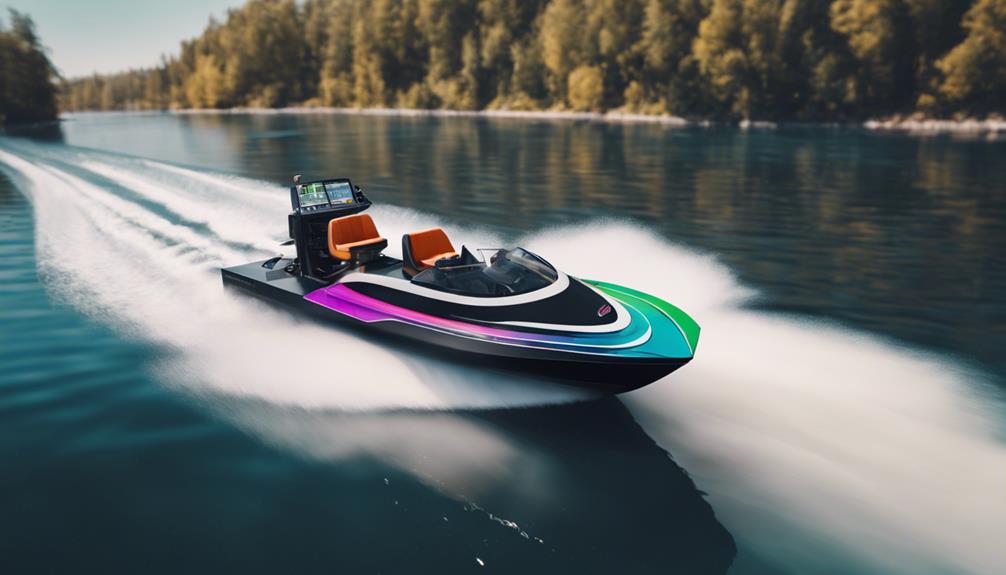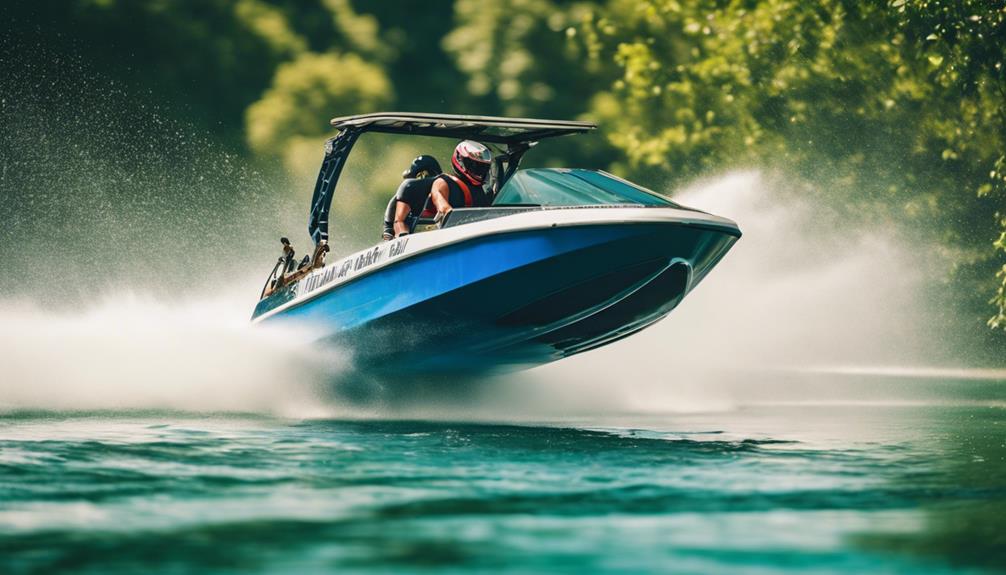Yes, jet boats do have a reverse mechanism, which enhances your ability to maneuver effectively when backing up. They utilize a reverse gate that redirects thrust for smooth backward movement, making them much easier to control compared to traditional prop-driven boats. Whether you have a single or twin-engine model, you'll find that jet boats offer remarkable agility and precision, especially in tight spots. To master reverse maneuvers, practice is key. As you explore more about jet boat capabilities, you'll discover additional tips to improve your handling and confidence on the water.
Key Takeaways
- Jet boats utilize a reverse gate to redirect thrust, allowing efficient backward movement.
- Single-engine models provide decent reverse handling, while twin-engine models enhance maneuverability in reverse.
- Proper operation of the thrust reverser is essential for effective maneuvering in reverse.
- Keeping the engine running is crucial for responsive control when reversing jet boats.
Jet Boat Backing Capabilities
Jet boats excel in backing capabilities, allowing you to maneuver in reverse with impressive control and ease. Thanks to their reverse gate, these boats can redirect thrust effectively, enabling smooth backward movement. This feature functions similarly to the systems found in jet airplanes, letting you enjoy precise handling without the typical struggles associated with prop-driven boats.
Single-engine jet boats offer decent reverse handling, but if you want enhanced maneuverability, consider a twin-engine model. The added power from dual engines helps you navigate tight spaces effortlessly. Users often report different experiences when it comes to reversing control, so it's essential to practice. Mastering the use of the reverse gate will greatly improve your confidence and skill.
Unlike traditional boats that require you to shift in and out of reverse, jet boats provide a seamless experience. You can back up steadily without the usual bumps and jerks, making it easier to position your boat exactly where you want it. With a bit of practice, you'll find that jet boats can offer superior backing capabilities, allowing you to enjoy your time on the water with greater ease.
Maneuverability and Control

With their unique propulsion system, these boats offer remarkable maneuverability and control, allowing you to navigate tight spaces effortlessly. Jet propulsion enables you to spin on a dime and slide sideways, often outperforming traditional propeller-driven boats. This agility becomes especially beneficial in crowded marinas or narrow channels.
When you need to steer in reverse, the movable nozzle directs water flow, relying on engine power for effective control. It's essential to recognize that the engine must be running for this maneuvering to work properly. The reverse thrust mechanism, utilizing a reverse bucket, allows you to back up smoothly, with single-engine models providing good control once you practice a bit.
Unlike conventional boats that may struggle with bumping in and out of reverse, jet boats maintain superior control while reversing thanks to their thrust reversers, similar to those in aircraft. However, mastering the intricacies of jet boat handling, particularly in reverse, does take some time. Each experience can vary, so familiarity with the unique steering dynamics of jet propulsion will greatly enhance your confidence and control on the water.
Comparisons With Other Boat Types

Comparing jet boats to traditional propeller-driven vessels reveals considerable differences in maneuverability and control, particularly when it comes to reversing and steering through tight spaces. Jet boats utilize a reverse bucket to effectively redirect thrust for backward propulsion, making them more efficient in tight situations. In contrast, traditional outboard and inboard boats often struggle with propeller-driven reverse, requiring more nuanced control.
When it comes to agility, jet boats have the upper hand. They can slide sideways and spin quickly, allowing you to navigate confined areas with ease. Unlike sterndrive boats that depend on steerable outdrives, jet boats steer by directing water through a movable nozzle. This results in more immediate and responsive handling.
Safety is another area where jet boats shine. With no external propellers, the risk of propeller-related accidents decreases considerably, especially in shallow waters. While you can back up effectively with a jet boat given some practice, sterndrives often need you to bump in and out of reverse to maintain controlled movement.
Importance of Practice

Mastering the art of reversing a jet boat takes practice, as the steering mechanism operates quite differently from traditional boats. The jet pump relies on engine power for directional control, making it vital to maintain engine operation while moving in reverse. Initially, you might find reversing challenging, but consistent practice helps build confidence and improve handling skills.
To visualize the importance of practice, consider the following table:
| Practice Focus | Benefits | Tips for Improvement |
|---|---|---|
| Engine Operation | Retains steering control | Keep RPM consistent |
| Thrust Reverser Use | Enhances maneuverability | Familiarize with controls |
| Open Water Sessions | Builds confidence and skill | Start in calm conditions |
Familiarity with the thrust reverser and reverse bucket mechanisms is essential for steering through tight spaces and performing successful docking maneuvers. Engaging in practice sessions in open water allows you to develop a better understanding of the unique handling characteristics of jet boats. So, don't shy away from putting in the time—it's key to mastering reverse maneuvering!
Community Insights and Experiences

Jet boat enthusiasts often share valuable insights from their experiences, highlighting the unique challenges and triumphs of reversing these powerful vessels. Many users stress that mastering reverse maneuvering takes practice, as your control can vary greatly based on your experience level and the conditions you encounter.
In forum discussions, some jet boaters boast about their excellent backing capabilities in tight spaces, while others reveal that handling in reverse can be trickier than expected. Experienced jet boaters recommend keeping the engine running while maneuvering. This practice helps maintain steering control and prevents a loss of power during turns.
Personal anecdotes from the community indicate that new jet boaters often face a steep learning curve. However, the shared tips and collective knowledge from seasoned enthusiasts can greatly enhance your skills.
Moreover, reports show that jet boats, when operated by familiar hands, can outperform traditional prop-driven boats in specific docking and maneuvering scenarios. So, as you immerse yourself in jet boating, remember that learning from others can make a world of difference in your journey to master reverse navigation.
Embrace the community insights; they can guide you to become a more proficient jet boat operator.
Jet Drive Boats Overview

Understanding jet drive boats reveals how their unique propulsion system and design make them ideal for traversing diverse waterways. Unlike traditional boats, jet boats utilize inboard engines linked to jet pumps. This setup draws water through a hull intake and expels it through a nozzle, providing powerful propulsion.
Here are some key features of jet drive boats:
- Steering Mechanism: The steering is managed with a movable nozzle that directs water flow, eliminating the need for rudders.
- Shallow Water Operation: Designed with a minimal draft, jet boats can operate in shallow waters, protecting them from propeller damage.
- Safety Features: The contained jet drive impeller minimizes the risk of injury from exposed components, enhancing safety, especially around the transom.
- Versatility: Jet drive boats can effectively navigate various marine environments, making them perfect for recreational activities or fishing.
Jet Boat Advantages
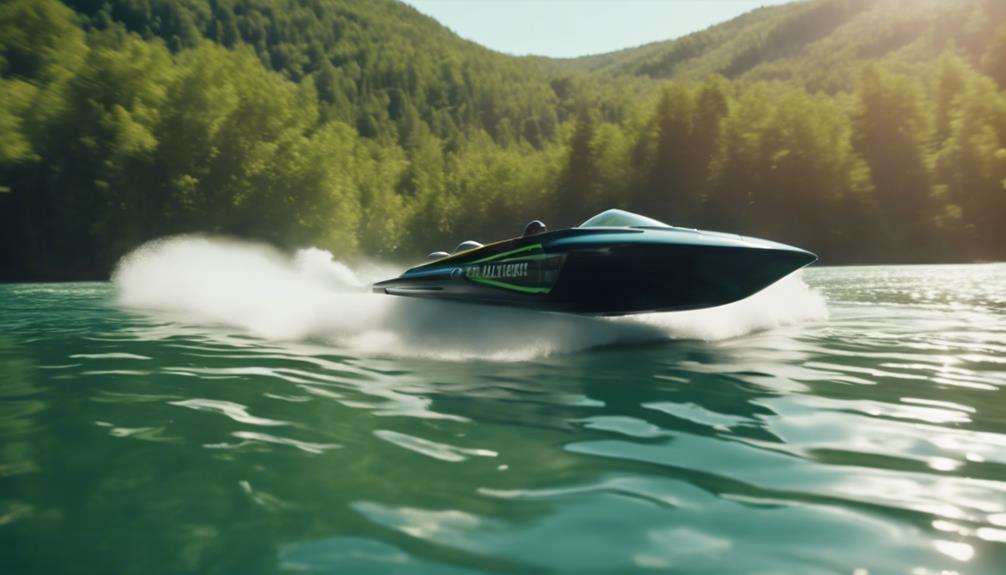
Jet boats come with some impressive advantages that make them stand out on the water.
You'll appreciate their ability to navigate shallow areas, allowing you to explore spots where traditional boats can't go.
Plus, their agility and speed mean you can make sharp turns and accelerate quickly, giving you a thrilling ride every time.
Shallow Water Navigation
Maneuvering shallow waters becomes a breeze with jet boats, which can operate in depths as low as 18 inches, opening up areas that traditional boats simply can't access. This capability is particularly beneficial for those who love exploring hidden coves and narrow channels.
Jet boats use a jet propulsion system that draws water in from the hull intake, providing effective steering without the risk of propeller entanglement.
Here are some advantages of jet boats when it comes to shallow water steering:
- Minimal Draft: Jet boats sit higher in the water, allowing you to glide over shallow areas safely.
- Reduced Impact Risk: With no external propellers, you won't have to worry about damaging your boat or the underwater environment.
- High Speed and Agility: Their design allows for quick lateral thrust, enabling you to maneuver around obstacles effortlessly.
- Stable Operation: Jet boats provide a stable experience, giving you peace of mind while steering unpredictable waters.
With these advantages, jet boats truly shine in shallow water environments, making your adventures more accessible and enjoyable.
Enhanced Maneuverability and Agility
Offering unmatched agility, jet boats can spin on a dime and slide sideways with ease, making them a top choice for maneuvering tight spaces. Their unique steering mechanism allows you to have precise control, even at low speeds, which is perfect for docking or steering through crowded areas. With thrust reversers similar to those in jet airplanes, jet boats can effectively reverse, enhancing their overall agility.
Here's a quick comparison of jet boats and traditional boats regarding maneuverability:
| Feature | Jet Boats | Traditional Boats |
|---|---|---|
| Turning Radius | Very Tight | Wider |
| Control at Low Speeds | Excellent | Limited |
| Reverse Capability | Yes (Thrust Reversers) | No |
The impeller in a jet boat remains in motion, keeping the boat responsive, even in challenging environments. Plus, with their ability to operate in shallow waters, jet boats can access areas off-limits to traditional boats, making them versatile for various recreational activities. So, if agility and maneuverability are what you need, a jet boat's got you covered!
Jet Boat Drawbacks

One major drawback of jet boats is their vulnerability to clogging from weeds or debris, which can significantly impact performance and maneuverability. When you're out on the water, you might find that these issues arise more often than you'd like.
Here are some key drawbacks to take into account:
- Clogging Risks: The pump intake can easily become clogged, reducing thrust and affecting speed.
- Limited Trim Options: Jet boats come with a non-trimmable nozzle, making it hard to adjust for passenger loads or changing sea conditions, which can lead to handling difficulties.
- Tracking Challenges: At no-wake speeds, jet boats often struggle with reduced tracking ability, which can make slow navigation feel unstable.
- Maneuverability: Maneuvering in tight spaces is tricky due to the always 'in gear' operation, causing slight wandering when you try to start from a neutral position.
To keep your jet boat performing reliably, regular maintenance is essential. Neglecting the engine and jet system can lead to significant performance issues down the line.
Sterndrive Boats Overview

Unlike jet boats, which rely on jet propulsion, sterndrive boats utilize a combination of an inboard engine and an outdrive to deliver power and control on the water. This system, often featuring a V6 or V8 engine, houses a steerable outdrive that contains the propeller at the transom. This location enhances power transfer efficiency, allowing you to steer your boat with precision, whether you're turning left or right.
One of the advantages of sterndrive boats is their ability to adjust trim. This feature lets you optimize thrust angles based on changing sea conditions, improving performance during your outings. However, keep in mind that the exposed propeller and outdrive are more vulnerable to underwater obstacles than the protected drives of jet boats.
Additionally, sterndrive systems come with more complex maintenance requirements. You'll need to pay attention to hydraulic systems and guarantee proper winterization to keep everything running smoothly.
Troubleshooting and Maintenance Tips
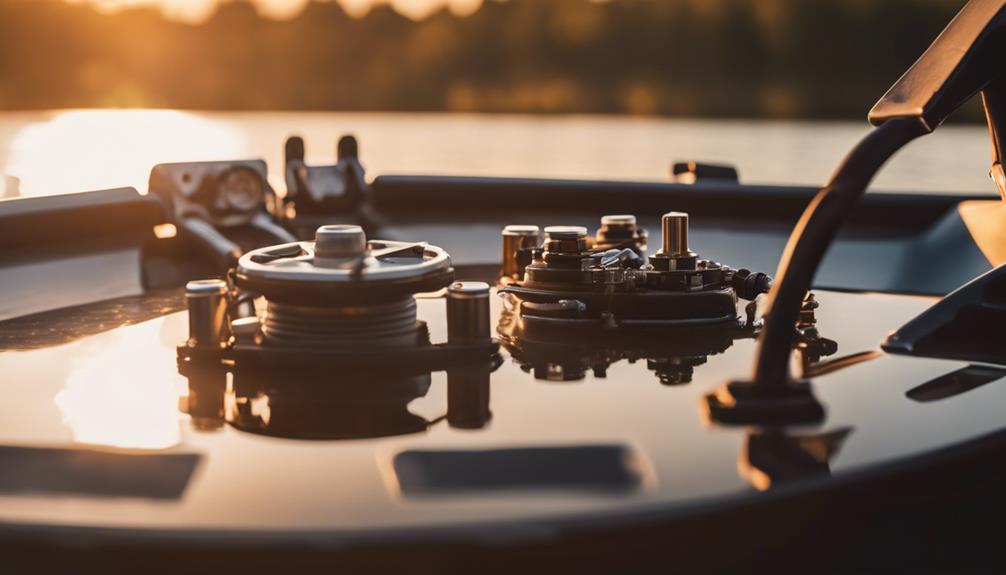
Proper maintenance and troubleshooting are vital for keeping your jet boat's reverse functionality reliable and safe. Regular checks can prevent issues and guarantee smooth operation. Here are some key tips to keep in mind:
- Inspect Reverse Cup Adjustments: Regularly check the reverse cup to verify it's properly engaged. A loose or malfunctioning cup can lead to dangerous reverse operation.
- Adjust Cable Tension: Proper cable tension is essential. Make sure the cables are adjusted correctly to avoid slippage in both forward and reverse. Slack can cause engagement issues.
- Utilize the Right Tools: Use penetrating oil to loosen stuck components. If you encounter stubborn metal parts, applying heat carefully can help during maintenance adjustments.
- Consult Resources: Don't hesitate to consult your installation manuals and community forums. They can provide valuable insights and repair techniques based on shared experiences.
Always remember to use certified parts and services for maintenance. This minimizes risks, especially when operating in shallow waters or at low speeds.
Taking these steps will help you maintain a safe and efficient jet boat experience.
Frequently Asked Questions
Do Jet Boat Motors Have Reverse?
Yes, jet boat motors have reverse capabilities. You can maneuver backward using a reverse bucket that redirects thrust. Just remember, the engine needs to run for steering control while you're in reverse.
What Are the Downsides of Jet Boats?
When considering jet boats, you might notice challenges like limited maneuverability around docks, susceptibility to debris, higher noise levels, and reduced fuel efficiency, all of which can impact your overall boating experience.
How to Steer a Jet Boat in Reverse?
To steer a jet boat in reverse, you'll need to use the movable nozzle to direct the water flow. Practice in open water helps you master the thrust dynamics and improve your control over steering.
What Is the Benefit of a Jet Boat Vs Prop?
When comparing jet boats to prop-driven ones, you'll notice jet boats offer better maneuverability, shallow water operation, and quicker changes between forward and reverse, making your experience smoother and safer in tight spaces and shallow waters.
What Are the Maneuverability Features of Jet Boats?
Jet boats are known for their exceptional maneuverability, and the ultimate jet boat trim tabs enhance this capability even further. By adjusting the tabs, the operator can optimize the boat’s performance, allowing for quick turns, better stability, and improved overall handling in varying water conditions.
Conclusion
In the world of jet boats, mastering reverse is like learning to dance on water—challenging yet rewarding. With the right practice, you'll glide effortlessly into tight spots, leaving onlookers in awe.
While jet boats offer unique advantages, they also come with their quirks, much like maneuvering a winding river. Embrace the journey, share your experiences with fellow enthusiasts, and soon enough, you'll be steering through any situation with confidence and flair.
Happy boating!

